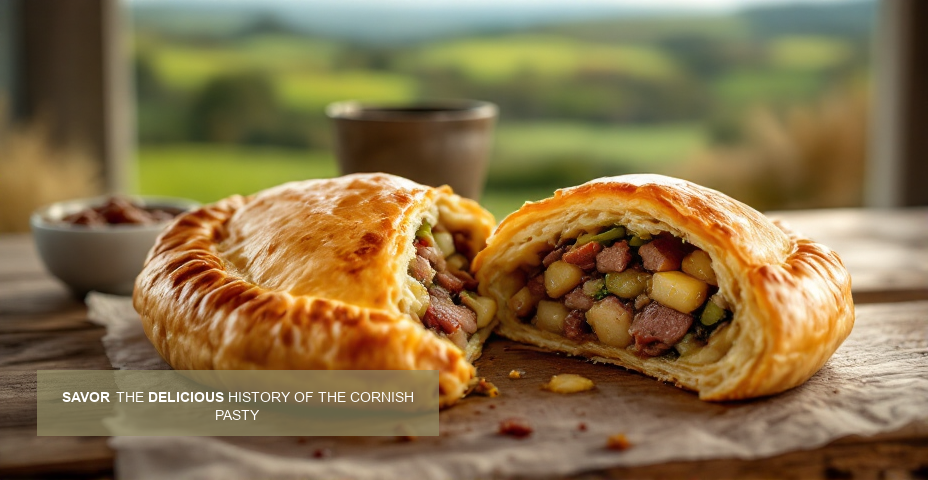The Cornish pasty stands as one of the most iconic British foods, representing centuries of culinary tradition and regional pride. This humble yet hearty pastry, with its distinctive D-shape and crimped edge, has fed generations of Cornish folk and now enjoys popularity throughout Britain and beyond. Far more than a simple snack, the Cornish pasty history is deeply intertwined with the cultural identity of Cornwall itself.
What makes the origins of the Cornish pasty particularly fascinating is how this food evolved from practical necessity to protected cultural treasure. In 2011, the traditional Cornish pasty received Protected Geographical Indication status from the European Union, recognizing its unique heritage and specific method of preparation. This Cornish pasty protected status ensures that only pasties made in Cornwall following the traditional recipe can bear the coveted name. The distinction firmly establishes Cornwall—and absolutely not neighbouring Devon—as the true birthplace of this beloved pastry, settling a regional dispute that has simmered for generations.
Origins of the Cornish Pasty: A Historical Perspective
The Cornish pasty has a rich history that dates back centuries, with some of the earliest documented references appearing in the 13th century. During this period, pasties were mentioned in royal household records, indicating they were already an established food. By the 16th and 17th centuries, more specific references to pasties from Cornwall began to emerge in various texts and cookbooks.
While the exact moment of Cornish pasty creation remains somewhat obscure, historical records show that pasties were initially consumed by the wealthy before becoming associated with the working class of Cornwall. Early versions contained various fillings, though they differed significantly from what we recognise today as the traditional Cornish pasty.
Development as a portable meal
The evolution of the Cornish pasty into its recognisable form coincided with the growth of the mining industry in Cornwall. Miners needed a portable, durable meal that could be eaten without cutlery and would stay warm for hours. The distinctive thick crimped edge was developed not merely as a seal but served a practical purpose - miners with dirty hands could hold the pasty by this crust and discard it afterward.
This is where the origins of Cornish pasty as we know it today truly solidified. The traditional filling of beef, potato, swede (rutabaga) and onion encased in pastry became standard by the 18th century. Some historical accounts suggest miners' wives would sometimes include a sweet filling at one end, creating a complete meal in a single package.
Regional variations across Cornwall
Despite what many assume about uniformity, the Cornish pasty story includes numerous regional variations throughout Cornwall. Families in different mining communities developed their own distinctive recipes and crimping styles. In some areas, pasties featured more potato, while others favoured a higher meat content.
The crimping technique itself varied significantly - pasties from the east of Cornwall typically featured crimping along the top, while those from the west had crimping along the side. These regional differences highlight how deeply embedded pasties were in local culture, with techniques and recipes passed down through generations. Today, these variations continue to exist alongside the Protected Geographical Indication (PGI) status that defines what constitutes an authentic Cornish pasty.
Cornish Pasties and Mining Heritage
The Cornish pasty became an essential part of a miner's daily sustenance during the 18th and 19th centuries. These hearty pastries provided a complete meal that could be easily carried into the depths of Cornwall's tin and copper mines. The robust pastry case acted as a protective container, keeping the filling warm for hours and protecting it from contamination in the dusty, dirty mining environment.
From Miners' Hands to Culinary Heritage
The Cornish pasty originated in the 17th century as a practical meal for tin miners. Its distinctive D-shape with crimped edge served as both a handle and disposal method for arsenic-contaminated hands. This ingenious design, born of necessity, transformed a humble pastry into Cornwall's most iconic cultural symbol.
Each pasty typically contained a mixture of meat, potato, swede (rutabaga), and onion - providing the energy and nutrition miners needed for their physically demanding work. The thick crimped edge along one side served as a practical feature, creating a sealed package that prevented the contents from spilling. Many pasties were marked with initials or distinctive patterns, allowing miners to identify their own lunch among those of their colleagues.
The 'handle' myth and reality
One of the most enduring stories about Cornish pasties is that the crimped edge was designed as a disposable handle. According to this tale, miners with arsenic-contaminated hands would hold the pasty by this crust and discard it afterwards to avoid poisoning. While this makes for a fascinating narrative, historical evidence suggests this was not the primary purpose of the crimp.
The reality is more practical - the crimped edge primarily served to seal the pasty and provide structural integrity. Miners valued every morsel of food, and the idea of discarding part of their meal seems unlikely given their economic circumstances. Some accounts suggest miners ate their pasties wrapped in cloth or paper to keep their hands clean, and the sturdy crust was indeed eaten rather than discarded.
Cultural significance in mining communities
Beyond mere sustenance, the Cornish pasty held deep cultural significance in mining communities. Miners' wives took great pride in their pasty-making skills, with family recipes passed down through generations. The quality of a woman's pasty was considered a reflection of her care for her husband, with a good pasty being a matter of considerable household pride.
Mining families developed traditions around the pasty, including the practice of leaving a corner of the pasty with a small amount of filling as an offering to the "knockers" - mythical spirits believed to inhabit the mines. These cultural practices demonstrate how the Cornish pasty transcended its role as food to become a symbol of mining identity and community solidarity throughout Cornwall.
Traditional Cornish Pasty: Ingredients and Methods
The authentic Cornish pasty adheres to strict guidelines that earned it Protected Geographical Indication status in 2011. A genuine Cornish pasty requires a specific set of ingredients: roughly diced or minced beef, potato, swede (also called rutabaga), and onion, seasoned simply with salt and pepper. These ingredients must be raw when filled into the pastry, allowing the flavours to meld during baking.
The pastry itself is equally important, traditionally made with a robust shortcrust that can withstand handling. The dough must be sturdy enough to hold the filling yet tender when baked. Many traditional recipes call for a mixture of lard and butter to achieve the perfect balance of flavour and texture. The pastry should be golden in colour when baked, with a texture that is firm but not too crumbly.
The crimping technique
Perhaps the most distinctive feature of a Cornish pasty is its crimped edge, which runs along the side rather than across the top. This side-crimp is not merely decorative but functional, dating back to the pasty's origins as a portable meal for miners. The thick crimped edge served as a handle that miners could hold with their dirty hands and then discard.
The traditional crimping technique requires dexterity and practice. Bakers pinch and fold the pastry edge to create a rope-like seal that is both secure and aesthetically pleasing. A properly crimped pasty will have between 20 and 30 crimps, each one firmly sealed to prevent the precious juices from leaking during baking. Many Cornish families take pride in their distinctive crimping styles, passed down through generations.
Regional variations and family recipes
While the basic components of a Cornish pasty remain consistent, subtle variations exist between different regions of Cornwall and family traditions. Some families prefer a coarser chop to their vegetables, while others cut them into precise cubes. The ratio of meat to vegetables also varies, with some recipes favouring more beef and others emphasizing the potato and swede.
Seasoning can also differ between families. While salt and pepper are standard, some traditional recipes incorporate a small amount of herbs such as parsley or even a touch of Worcestershire sauce. Despite these variations, authentic Cornish pasties never contain carrots, peas or any meat other than beef - elements that would immediately identify an impostor pasty to a true Cornish connoisseur.
Protected Status and the Devon Controversy
In 2011, the Cornish pasty received Protected Geographical Indication (PGI) status from the European Union, joining the ranks of Champagne and Parma Ham. This designation means that only pasties made in Cornwall following the traditional recipe can legally be sold as "Cornish pasties". The protection came after years of campaigning by the Cornish Pasty Association.
Under PGI regulations, a genuine Cornish pasty must have a distinctive 'D' shape with a side crimp, contain a specific filling of beef, potato, swede and onion, and be prepared in Cornwall. This protection preserves the authenticity of this traditional Cornish food and prevents imitations from using the coveted name.
The Cornwall vs Devon debate
The rivalry between Cornwall and neighbouring Devon over pasty origins has been long-standing. While Devon has made claims to inventing the pasty, historical evidence strongly favours Cornwall. The earliest documented reference to pasties in Cornwall dates back to the 13th century, whereas Devon lacks such early records.
Cornwall also has deeper cultural connections to the pasty. Mining records from the 18th and 19th centuries consistently show how the pasty became integral to Cornish mining culture. The distinctive crimped edge, developed to give miners a handle to hold without contaminating their food with arsenic from the mines, is uniquely Cornish in design and purpose.
Modern popularity and global reach
Today, the Cornish pasty has spread far beyond the borders of Cornwall. Cornish miners took their beloved pasties to mining regions across the world during the 19th century, establishing pasty traditions in places as far-flung as Michigan in the USA, parts of Australia, and Mexico.
Despite this global reach, the authentic Cornish pasty remains tied to its homeland. The pasty industry generates over £300 million annually for the Cornish economy and employs thousands of people. This economic impact, combined with its cultural significance, demonstrates why protecting the origins of the Cornish pasty remains so important to Cornwall and its heritage.
Summary of The Enduring Legacy of the Cornish Pasty
The Cornish pasty remains an essential part of Cornish identity and cultural heritage. From its humble origins in the tin mines of Cornwall, this portable meal has evolved into a protected food product that symbolises the ingenuity and practicality of Cornish people throughout history.
While modern variations exist worldwide, the traditional Cornish pasty—with its distinctive D-shape, crimped edge, and specific filling requirements—continues to be safeguarded by Protected Geographical Indication status. This protection ensures that authentic Cornish pasties can only be produced in Cornwall, firmly establishing their regional origin and countering any claims from neighbouring Devon.
The balance between maintaining tradition and allowing for contemporary adaptations demonstrates how this simple yet ingenious food item has managed to remain relevant across centuries, serving as both a practical meal and a powerful symbol of Cornish craftsmanship and heritage.







